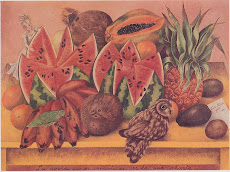Richard sent this to me in October. Apologies for the delay in posting it.
Ian
-----------
Hi Ian and all
I found the paper absorbingly interesting, on a whole range of levels, but confine my points to the nature of the collaborative in which we have been engaged (and in the same breath would add to everyone, thanks for so many stimulating ideas and angles in the blog discussion and the
paper)
As I read the draft I found myself reflecting on how the trilogy of papers, and in particular this paper, might perform for an international readership and to the on-the-ground study/investigation of the realities of food and agriculture in different places.
The present paper is an experiment in representing and performing collaboration. There are elements of both co-learning and co-production in at least three ways: IC in conjunction with the rest of us, we as we participate differently in knowledge spaces because of the IC intervention and possibilities of new co-learning and co-production that might be mobilised by readers of the paper. In this respect the paper's relationality is unusual. The first read, the paper itself, provides a sense of disturbance, positioning and scoping through multiple voices and the tensions that come from the ordering and juxtaposition on particular pages. A second read, the fuller blog, contextualises and grounds voice. Voice is given new potentiality through the intervention. In journal like PIHG the basic diet of papers is overview statements that are sweeping, summary and often stifling (as while they may strive to be inclusive they usually mis the mark). The present paper is more in-view like, offering explicit content on actual projects, from multiple intellectual and institutional trajectories. This is less representational and more performative, since the voice-bites are performing the person and their concerns/suggestions/insights rather than declaring new narratives.
In another way the paper performs as a knowledge space. I found Mol's book exploration of parallel but interdependent text quite illuminating, as it was in the conceptual space between the different texts that quite new work was done, at least when I was reading it. It seemed a neat way
of breaking some of the constraining qualities of single narratives. The current paper is also analogous to what is often done in workshops and meetings, when people sit in a circle and share 'disciplined' remarks on a topic. The basis of exploration is heightened by the buzz
factor. The interactive potential, set up by the material organisation of the paper, is intriguing. What points of entry and departure will be performed as the paper is read? For me this is one of the paper's primary provocations
cheers
Richard
Friday, January 8, 2010
Subscribe to:
Posts (Atom)
